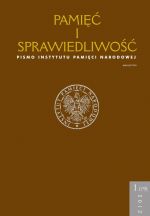Formy oporu społecznego związanego z wyborami powszechnymi w Polsce w okresie „małej stabilizacji” – zarys problematyki
Forms of social resistance associated with universal elections in Poland in the period of “Little Stabilisation” – outline
Author(s): Tomasz DanileckiSubject(s): History, Recent History (1900 till today), Post-War period (1950 - 1989)
Published by: Instytut Pamięci Narodowej
Keywords: social resistance;universal elections; Władysław Gomułka; political st
Summary/Abstract: Forms of social resistance associated with universal elections in Poland in the period of “Little Stabilisation” – outline universal elections in the People’s Republic of Poland (PRL) were never free, therefore, they did not reflect the true social attitude towards the system and individual governments; they only reaffirmed the rulers’ political preferences in formal terms. They were a tool used to legitimise the system, perform a selection done by upper party authorities amongst the members of “upper bureaucratic class” and a peculiar survey to measure social support and the rulers’ ability to exert control over society. Social opposition to electoral incapacity was present with varying force throughout the period of PRL, even though historians were mentioning it sporadically and tritely, usually on margin of the descriptions of electoral campaigns that took place in times crucial for the nation, such as elections to the Legislative Parliament in 1947, or the first parliamentary elections after the October turning point of 1956. Resistance to elections was proportionate to the restrictions of voting freedom imposed by the authorities, and the applied repressions. In the first elections of the “Gomułka era” – in 1957 and 1958 – its relatively most frequent forms were open (speeches at electoral meetings, letters addressed to the authorities, voting behind curtain) and, in a small degree, nonetheless organised (attempts to put forward independent electoral lists, organise electoral campaigns for candidates placed on so-called non-mandate [low] positions on voting lists, crossing off individual candidates according to a common scheme). With the progress of system stabilization and atomisation of society that was unified for a short time after October 1957, acts of resistance related to elections gradually became increasingly anonymous and dispersed (crossing off concrete candidates and entire voting cards behind the curtain, taking away or destroying voting cards, adding notes on voting cards). Their geographic location mainly comprised the conservative rural areas of southern and eastern Poland, and large urban centres. The force of opposition against elections diminished as the mobilisation measures intensified, after 1956 one of the primary tools of defending the system that was undermined by the changes of October 1956. The increasing passivity and indifference (also as a result of deteriorating living standards) since the early 1960s were leading to increasingly frequent replacing of resistance by adjustment, that consisted in treating the vote as a meaningless ritual; consequently it evolved into one of the most evident examples of collective mimesis.
Journal: Pamięć i Sprawiedliwość.
- Issue Year: 19/2012
- Issue No: 1
- Page Range: 107-134
- Page Count: 28
- Language: Polish

